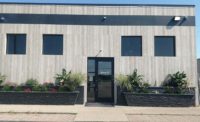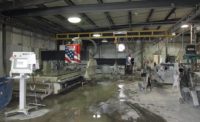Stone World magazine had the opportunity to talk to fabricator, innovator and inventor, Aaron Crowley, about how he got into the business and comes up with his invention ideas.
SW: How did you get started in the fabrication business?
AC: I got a summer job by accident in high school; my parents were of the mind that we worked. So I got fired from a gas station and my parents reminded me of their expectations of me working. I was literally just out knocking on doors in a business park in 1993, which was the summer before my senior year of high school. I walked into a shop, probably one of six shops at the time. They were just hiring for a helper. I got this job and people would be like, what do you do? I would say, I don’t know, it’s like granite countertops or something. Back then, no one had even heard of that. It was just so new. So that started my career and I ended up working with them for five years. All through my senior year of high school. Then in 1998 I decided to start my own little independent contractor installer enterprise. That was my idea. My expectation was probably that I wouldn’t even make it a year, but I started at the right time and then the rest is history. So I have owned a fab shop since 1998.
SW: Along the way you have invented and innovated and done different things, what’s been the process for that?
AC: The benefit was getting into the industry in the late 90s/early 2000s in what you could say was its infancy, and it’s definitely maturing now. There was just a lot of opportunity to innovate and create solutions. It’s a tough job to fabricate and install. The first idea or product I had was called at the time the Stone Sleeve. As most know, wet polishing isn’t the most pleasant job to do. I was having a conversation with a friend of mine who water skied year-round. I said I just can’t imagine doing that year-round in Oregon. Then he described what a dry suit was and how it worked, and as he is describing this waterproof wrist seal, I go that’s the solution to me being sopping wet and freezing cold all winter. I literally went to a phone book and found a water sports store and called him. This was back in 1999. I asked him if he had dry suits, and he did. I raced down there and went to the dry suit section and pulled this dry suit sleeve onto my arm and realized this is it. Somebody had already solved the problem, it just hasn’t been applied to wet polishing in the stone industry. Long story short, I contacted the manufacturer and he sent me just some sleeves and I started selling them just to friends of mine. I sent them off to the buyer’s and Braxton-Bragg at the time had a purchasing manager there. He said, “A lot of the things we think will be big hits will flop and the things we think will have no chance take off, so send me a box of 50.”
SW: Now more recently it’s been No Lift Systems, right?
AC: I have been in the business for 22 years, hiring installers and losing them. The highest turnover we had was always in the installation department. It’s because the work is so hard on people’s bodies. I installed for the company that I worked at for a few years before I went into business for myself. I had a couple of injuries that just catch up with you. I am not a big guy and I had a doctor tell me, you got one of two choices here. The physical body was not built, it is not designed and it is not constructed to do what your job requires you to do. So you can either persist in this and eventually not be able to function, or you can go find another career. I was like well the career has already been established so that’s not an option. So I came out of it experiencing the detrimental effects of installing as an employee. Then I turned right around and started hiring other people to do that for me. For years, we were doing 2cm so it wasn’t nearly as heavy, but once the 3cm trend took over, it just bothered me for years that we were asking people to install that. Around 2013, it reached a point of where I was thinking we either need to solve this problem or I need to get out of this business. I cannot keep asking people to do this. Long story short, my uncle who had been in manufacturing and who was pretty familiar with my business and had been around it for years, [helped me]. He is a really innovative guy. He came to me with a sketch and said, “Aaron, you got to build a cart that performs this function. That mechanically lifts this and rotates the frame into the horizontal position.” I kind of blew that off. It was 2013, and we were just recovering from the great recession and were just trying to survive. A couple of years later, we had two really good installers that had been with me for years and they were telling me that they would have to find something else to do. They said that they can’t keep doing this because they are hurting.
So we built the first prototype. I took that sketch and bought a welding kit, a metal band saw and a drill press, and we constructed it. I welded it to an old sheetrock cart. From there we proved the functionality would solve that problem. A lot of times it isn’t the heaviest pieces that are the problem, it’s the awkward shapes where guys have to contort their body to prevent the countertop from breaking. A lot of that first prototype was that we still use the bulk of that concept, at least. My uncle stepped in and we did four complete rebuilds. We would get one out and give it to the guys. They would still complain about it because it was easier to just get out there and do it themselves and not with the cart. We joked that if we could ever get this to the point where they won’t leave without it that would be something. Anyway, we got to the point where one of those original installers came to me and said, “Aaron, I am never going to another jobsite again without this cart.” It had finally clicked that the cart design was functional and reached the point where he needed it to be useful, and he connected that this cart could extend his career.






